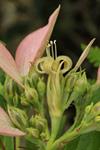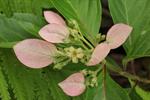Click the number at the start of a key lead to highlight both that lead and its corresponding lead. Click again to show only the two highlighted leads. Click a third time to return to the full key with the selected leads still highlighted.
1 Trees, shrubs, or woody vines. |
..2 Prostrate or climbing woody vines (lianas), or sprawling shrubs. |
....3 Leaf bases cordate, rounded, or truncate; leaves usually cordate, ovate, or deltoid shaped (occasionally hastate or broadly elliptic); corolla pale lilac colored; [non-native, se. US including FL; tribe Paederieae] |
....3 Leaf bases cuneate to rounded but not cordate; leaves oblanceolate, lanceolate or linear; corolla white or yellow; [native, FL]. |
......4 Flowers and fruit sessile or subsessile; fruit yellow |
......4 Flowers and fruit borne on pedicels or peduncles; fruit white |
..2 Shrub or tree, plants upright. |
........5 Inflorescence spherical or globular, in a tight round head; [collectively widespread] |
..........6 Fruits dry, dehiscent; [subfamily Cinchonoideae; tribe Naucleeae] |
..........6 Fruits fleshy, indehiscent; [subfamily Rubioideae; tribe Morindeae] |
........5 Inflorescence cymose, thyrsoid, or corymbose (the inflorescence more open, not round and compact); [Coastal Plain, from s. SC southward]. |
............ 7 Plants with paired spines. |
............ ..8 Corolla lobes 4; leaves to ca. 1 cm long; fruit ca. 5 mm long |
............ ..8 Corolla lobes 5; leaves ca. 2-5 cm long ; fruit ca. 10 mm long |
............ 7 Plants unarmed, not bearing spines or thorns. |
............ ....9 Flowers orange-red; leaves usually whorled; [subfamily Cinchonoideae; tribe Hamelieae] |
............ ....9 Flowers white, green, or maroon; leaves opposite. |
............ ......10 Leaves linear, revolute, and strongly congested; [FL keys southward] |
............ ......10 Leaves broad, not linear, nor strongly congested; [collectively more widespread] |
............ ........11 Flowers solitary, terminal; [subfamily Ixoroideae; tribe Gardenieae] |
............ ........11 Flowers in cymose or thyrsoid inflorescences. |
............ ..........12 Inflorescence cymose; some calyx lobes expanded into pink or reddish “flags”; leaves deciduous; domatia not present; [of s. SC southward]; [subfamily Ixoroideae; tribe Condamineeae] |
............ ..........12 Inflorescences thyrsoid; calyx lobes inconspicuous; leaves evergreen; domatia present in secondary vein axils; [of ne. FL southward] |
 Show caption*© Sequoia Janirella Wrens, some rights reserved (CC BY-NC), uploaded by Sequoia Janirella Wrens Show caption*© Sequoia Janirella Wrens, some rights reserved (CC BY-NC), uploaded by Sequoia Janirella Wrens ............ ............ 13 Lateral veins 3-6 on either side of the midvein; fruit white; petals yellowish, > 6 mm long; [subfamily Cinchonoideae; tribe Chiococceae] |
............ ............ 13 Lateral veins 8-14 on either side of the midvein; fruit red; petals white, <5 mm long; [subfamily Rubioideae; tribe Psychotrieae] |
1 Herbs (or creeping subshrubs in Mitchella). |
............ ............ ..14 Leaves whorled; [subfamily Rubioideae; tribe Rubieae] |
............ ............ ..14 Leaves opposite |
............ ............ ....15 Flowers paired, the ovaries connate and developing into a single fleshy red fruit; leaves roundish; creeping subshrub; [subfamily Rubioideae; tribe Mitchelleae] |
............ ............ ....15 Flowers single or in inflorescences with multiple flowers, the fruits either dry or fleshy and yellowish or black; leaves various; herb; [subfamily Rubioideae; tribe Spermacoceae]. |
............ ............ ......16 Carpels with few to many seeds. |
............ ............ ........17 Corolla 5-lobed |
............ ............ ........17 Corolla 4-lobed. |
............ ............ ..........18 Capsule longer than the calyx tube; flowers blue, pink, or white |
............ ............ ..........18 Capsule not longer than the calyx tube; flowers white |
............ ............ ......16 Carpels 1-seeded. |
............ ............ ............ 19 Flowers in dense, terminal, involucrate heads; flowers 4- or-6-lobed; styles 3 |
............ ............ ............ 19 Flowers in axillary or terminal clusters, or single in axils, not involucrate; flowers 4-lobed; styles 2. |
............ ............ ............ ..20 Flowers usually solitary in leaf axils; fruit separating into 2 parts. |
............ ............ ............ ....21 Sepals 4 and similar in size; style entire; [of dry habitats] |
............ ............ ............ ....21 Sepals 2 (or 4, and then markedly dimorphic); style cleft; [of moist to wet habitats] |
............ ............ ............ ..20 Flowers in terminal and axillary clusters; fruits not separating into 2 parts. |
............ ............ ............ ......22 Carpels opening transversely |
............ ............ ............ ......22 Carpels opening longitudinally |
1 Leaves deciduous (medium to pale green, thin in texture); leaves strictly opposite. |
..2 Leaves 10-70 cm wide, cordate or subcordate at the base; flowers 5-merous, bilaterally symmetrical, large (20-70 mm long), the petals connate into a tube; fruit a capsule. |
....3 Flowers white to yellow; capsules linear, >10× as long as wide; leaf undersurface with curly simple hairs; nectar glands present in the main vein axils on the undersurface of the leaf (visible from the underside or the upperside in fresh leaves and herbarium specimens as a triangle 1-4 mm on a side) |
....3 Flowers lavender; capsules ellipsoid, < 2× as long as wide; leaf undersurface with branched (dendritic or stellate) hairs; nectar glands absent |
..2 Leaves 1-12 cm wide, cuneate to rounded at the base; flowers 4-6-merous, radially symmetrical, small to medium (< 25 mm long), the petals either connate into a tube or separate and clawed; fruit a drupe or capsule. |
......4 Leaves with prominently parallel-arcing secondary veins; corolla 4-merous, < 8 mm long, white to cream; inflorescence a many-flowered corymb or head; flowers white to cream; fruit a drupe |
......4 Leaves with complexly branching secondary and tertiary veins; corolla 5-6-merous, 12-25 mm long, either greenish-yellow and mottled with purple, or white, pink, or purple; inflorescence a few-flowered cyme or many-flowered cymose panicle; fruit a capsule. |
........5 Leaves 4-20 cm long, 2.5-12 cm wide; petals connate into a 15-25 mm long tube, either greenish-yellow and mottled with purple; some calyx lobes expanding to 7 cm long and 5 cm wide, petaloid (pink to yellowish); capsule 2-valved; [native, in saturated, boggy seepages and streamheads, se. SC to FL] |
........5 Leaves 2.5-7 cm long, 1.5-4 cm wide; petals separate, clawed, 12-20 mm long (including the 6-9 mm long claw), white, pink, or purple; calyx remaining small and sepaloid (3.5-5 mm long); capsule 4-6-valved; [introduced, persistent from planting in upland to moist situations] |
1 Leaves evergreen (dark green or gray-green, thick in texture); leaves opposite or subopposite (offset by < 2mm from the opposing leaf). |
..........6 Mangroves, with one of various adaptations to growing in tidal or near-tidal, saline situations: prominent salt-excreting glands on the petiole ( Laguncularia in COMBRETACEAE), or prop roots ( Rhizophora in RHIZOPHORACEAE), or abundant pneumatophores ( Avicennia in ACANTHACEAE); [FL and less commonly subtropical shores of other, especially Gulf Coast, southeastern states]. |
............ 7 Leaves broadly elliptic, light green on both surfaces, rounded to broadly cuneate at the base, rounded and often retuse at the tip; petiole with 2 prominent salt-excreting glands; plants with neither prop-roots from the trunk and branches, nor pneumatophores from the roots |
............ 7 Leaves narrowly elliptic, dark green above, cuneate at the base, acute to obtuse at the tip; petiole without salt glands; plants with either prop-roots from the trunk and branches, or pneumatophores from the roots. |
............ ..8 Plants with numerous pneumatophores ascending from the roots and terminating in a blunt tip; leaves gray on the undersurface |
............ ..8 Plants with prominent prop-roots descending to the ground from the trunk and branches; leaves light green on the undersurface |
..........6 Non-mangroves; [collectively widespread]. |
............ ....9 Secondary leaf veins relatively few, further branching and reticulating into the tertiary vein structure; [collectively widespread]. |
............ ......10 Leaves strictly opposite, blue- or gray-green on both surfaces, suborbicular (about as wide as long), strongly aromatic when fresh |
............ ......10 Leaves opposite or subopposite (offset by < 2mm from the opposing leaf); dark green above, pale green below; oblancolate, elliptic, or ovate (distinctly longer than wide), not aromatic when fresh |
............ ........11 Twigs with spines; leaf venation with 3 primary veins from near the blade base; fruit a spherical berry, 5-12 cm long |
............ ........11 Twigs lacking spines; leaf venation pinnate; fruit an elliptical drupe, < 2.5 cm long |
............ ....9 Secondary leaf veins very many, closely parallel to one another and extending unbranched to the leaf margin. |
............ ..........12 Leaves elliptic, widest near the midpoint of the blade, ca. 2× as long as wide; flowers in axillary thyrses; fruit a 1-seeded drupe, 2-4 cm long |
............ ..........12 Leaves spatulate, widest towards the broadly rounded tip, ca. 1.2-1.6× as long as wide; flowers terminal on the branches, 1-3; fruit a leathery capsule, (4-) 6-9 (-12)-valved, 5-8 cm long |






